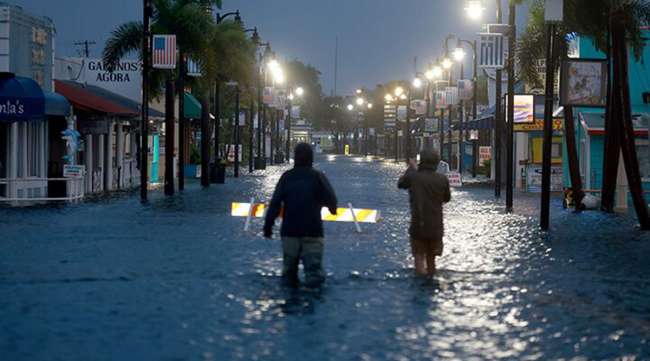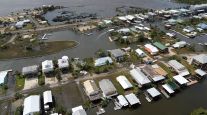Bloomberg News
Florida Starts to Recover as Idalia Rain Hits North Carolina

[Stay on top of transportation news: Get TTNews in your inbox.]
Florida has started to dig out from the aftermath of Idalia, which weakened to a tropical storm even as it brought heavy rain across Georgia and the Carolinas.
While the hurricane caused billions of dollars in damage, left hundreds of flights grounded and thousands without power, Florida Gov. Ron DeSantis expressed relief that it didn’t cause any known deaths.
“To be here and not have any reported fatalities — it’s probably not something most people would have bet on four or five days ago, knowing how strong this storm was,” the governor said at a briefing in Tallahassee on Aug. 31.
DeSantis issued two emergency waivers for commercial motor vehicles and certain hours-of-service requirements and size/weight restrictions were lifted. Georgia, Kentucky, North Carolina and South Carolina posted similar waiver orders Aug. 29.
Idalia’s top winds were at 60 mph as the storm crawled toward the North Carolina coast on its path back out to the Atlantic, the National Hurricane Center said in an advisory at 8 a.m. local time. Still, the center warned of life-threatening flash flooding in parts of the state. Officials continue to assess damage after Idalia came ashore in Florida Aug. 30 as a Category 3 hurricane.
5am Thu 31 Aug Key Messages for Tropical Storm #Idalia. Flooding due to heavy rains & coastal flooding due to strong winds on the backside of Idalia will continue across coastal North Carolina through today. https://t.co/y75tVkKnUz pic.twitter.com/WhpDOWMKNk — National Hurricane Center (@NHC_Atlantic) August 31, 2023
Tampa International Airport was back in operation on the morning of Aug. 31. More than 1,000 flights were canceled into and out of the U.S. on Aug. 30, with many cancellations at Tampa and Atlanta airports, according to FlightAware.
Reports of damaged buildings and flooding have poured in from Florida’s coastal counties and at least one case of looting in Steinhatchee, about 16 miles southeast of where Idalia came ashore with 125-mph winds.
Idalia was the second major hurricane to hit western Florida in a year. Last September, Hurricane Ian struck farther south, killing at least 150 people and causing more than $112 billion in damage. The Aug. 30 storm came ashore in a sparsely populated area of the state’s Big Bend region and will likely cause $10 billion to $20 billion in damage in Florida and across the South. It is possible Idalia could go on to hit Bermuda early next week.
“There were approximately 1 million people within 30 miles of landfall for Ian, while there are about 38,000 people within that distance for Idalia,” AccuWeather Inc. said.
The storm is drenching the coastal Carolinas just ahead of the Labor Day weekend. The stretch of North Carolina’s Outer Banks from Ocracoke Inlet to the village of Duck — usually popular with vacationers this time of year — could see a storm surge of much as 3 feet, according to the hurricane center.
WHEELS DOWN! ❤️ The first passenger flight just arrived at TPA post-closure. ⁰⁰As a reminder, we are open only to arriving flights today and reopening fully tomorrow at 3 AM. ⁰⁰Please check with your airline for the latest flight updates ✈️ pic.twitter.com/xzz33G07wN — Tampa International Airport ✈️ (@FlyTPA) August 30, 2023
Parts of the region are likely to see as much as 6 inches of rainfall by Thursday afternoon. Flash, urban and river flooding is likely, “with considerable impacts,” it added.
As of 9:19 a.m., about 288,000 people in Florida, Georgia, North Carolina and South Carolina were without power, according to PowerOutage.us. About 420,000 Florida accounts that lost power have been restored, DeSantis said at the briefing.
Idalia brought flooding to most of Florida’s West Coast, with the area around Tampa Bay and Clearwater seeing water rising as much as 5.2 feet, according to the National Ocean Service. In St. Petersburg, officials closed the pier and asked people to avoid the area.
Some of the hardest-hit areas in the state had widespread power outages and some businesses caught fire while others had their roofs knocked off, said Kevin Guthrie, executive director of the Florida Division of Emergency Management.
President Joe Biden approved federal emergency declarations for Florida, allowing the Department of Homeland Security and the Federal Emergency Management Agency to coordinate relief efforts. Georgia Gov. Brian Kemp, South Carolina Gov. Henry McMaster and North Carolina Gov. Roy Cooper all declared emergencies as well.
Today, EPA issued an emergency fuel waiver to address a fuel supply emergency in Florida caused by #HurricaneIdalia. Waiving federal requirements to sell summer gasoline can help address these supply shortages. https://t.co/Yn0rIxBJC1 — U.S. EPA (@EPA) August 30, 2023
Idalia steered clear of most oil and natural gas platforms in the Gulf of Mexico. But fuel markets were effectively closed with terminals shut in Tampa and Jacksonville, Fla., and Savannah, Ga., as the stormed passed through.
The Environmental Protection Agency is waiving summertime gasoline volatility requirements in Florida in an attempt to boost fuel supply and keep prices low. The waiver allows sales of fuel with higher volatility through Sept. 15.
— With assistance from Anna Jean Kaiser, Chunzi Xu, Sheela Tobben, Dayanne Sousa, Shoko Oda and Brian Wingfield.
Want more news? Listen to today's daily briefing below or go here for more info:



